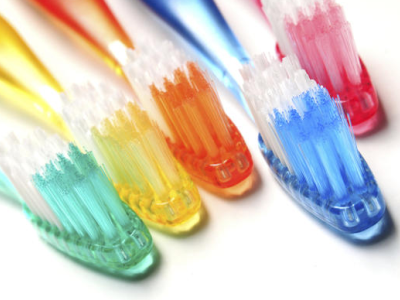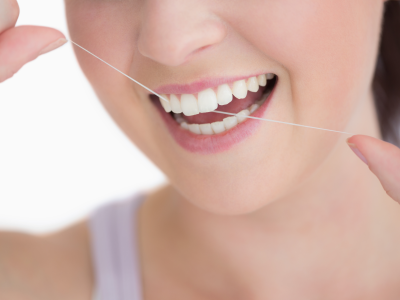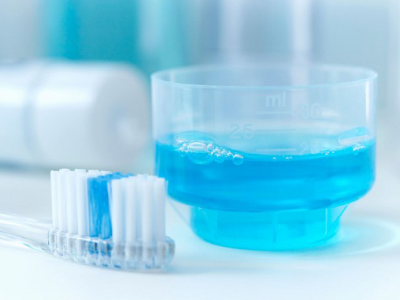Brushing your teeth is not just for a whiter smile and fresher breath, it’s important for your overall health. When you brush, you remove plaque—a thin film of bacteria that sticks to your teeth and will cause cavities, gum disease, and if you ignore it long enough, will cause your teeth to fall out! Bad breath due to a smelly mouth may keep people away from you.You know why to brush, but if you would like to learn how to brush your teeth effectively, this is for you. Read on!
 Use a good toothbrush. Choose a toothbrush with soft nylon bristles. This must effectively remove plaque and debris from your teeth, without irritating the gums or eroding tooth enamel like hard bristled brushes can do. The toothbrush should also fit comfortably in your hand, and have a head small enough to easily reach all of your teeth, especially the ones at the back.
Use a good toothbrush. Choose a toothbrush with soft nylon bristles. This must effectively remove plaque and debris from your teeth, without irritating the gums or eroding tooth enamel like hard bristled brushes can do. The toothbrush should also fit comfortably in your hand, and have a head small enough to easily reach all of your teeth, especially the ones at the back.
Electric toothbrushes are a great choice if you are a lazy brusher and think that the electric toothbrush might encourage you to spend more time on your teeth. However, you can do just as good of a job with a manual toothbrush — it’s all in the technique.
Replace your toothbrush at regular interval. The bristles will wear out over time, losing their flexibility and effectiveness. You should get a new one every 3 to 4 months, or as soon as the bristles start to splay out and lose their shape. Visual inspection of the toothbrush is more important than the actual timeline.
Research has found that thousands of microbes call toothbrush bristles and handles “home,” and can cause infections.
Always rinse your brush after using it, and store it upright and uncovered so that it can dry before your next use. Otherwise bacteria will grow.
Use a fluoride toothpaste. It not only helps remove plaque, it also helps strengthen tooth enamel. However, it’s important to note that fluoride toothpaste is not to be swallowed, as ingesting too much can have serious health consequences. It should not be used for children under the age of 3.
You can get toothpastes to target a wide variety of dental and gum problems, including cavities, tartar, sensitive teeth and gums, gingivitis and stained teeth. Opt for the one that suits your best or ask your dentist or hygienist for advice.
 Use dental floss. Flossing your teeth is just as important as brushing, as it removes built up plaque, bacteria and food particles that get trapped between the teeth and which soft floppy toothbrush bristles can’t reach even when used with up/down natural motion. You should always floss before brushing your teeth so that any food or bacteria that comes loose during flossing doesn’t remain in your mouth.
Use dental floss. Flossing your teeth is just as important as brushing, as it removes built up plaque, bacteria and food particles that get trapped between the teeth and which soft floppy toothbrush bristles can’t reach even when used with up/down natural motion. You should always floss before brushing your teeth so that any food or bacteria that comes loose during flossing doesn’t remain in your mouth.
Remember to floss gently. Don’t “snap” the floss between the teeth as this can irritate sensitive gums. Ease it down gently, following the curve of each tooth.
If you find dental floss awkward to use or you have braces, look for dental picks instead. These are small wooden or plastic sticks which you can insert between teeth, achieving the same results as flossing if spaces are large enough.
Use a small amount of toothpaste. Squeeze only a pea-sized amount of toothpaste onto your toothbrush. Applying too much toothpaste can cause over-sudsing, tempting you to spit and finish too early. Plus, it increases the risk of you ingesting more fluoride-filled toothpaste, which is very unhealthy.
If brushing is painful, try brushing more gently with accurate up/down motion only or switch to a toothpaste formulated for sensitive teeth.
 Set your bristles at the gum line at a 45-degree angle. Gently brush with a short, vertical or circular motion. Don’t brush across your teeth.
Set your bristles at the gum line at a 45-degree angle. Gently brush with a short, vertical or circular motion. Don’t brush across your teeth.
Spend at least three to five minutes brushing. Brushing just a few teeth at a time, work your way around your mouth in a cycle (start outside lower left round to outside lower right then outside upper right to upper left, change to inside uppers before inside upper right ,inside lower right, finally inside lower left). so that you get every tooth, spending about 12 to 15 seconds in each spot. If it helps, you can divide your mouth into quadrants: top left, top right, bottom left, and bottom right. If you spend 30 seconds on each quadrant, you’ll get a full two minutes of brushing time in.
Brush your back teeth(molars). Position the toothbrush so that the bristles are resting on top of your bottom molars. Work the toothbrush in an in-and-out motion, and move from the back of your mouth to the front. Repeat on the other side of your mouth. When the bottom teeth are clean, flip the toothbrush over and work on the top molars. To access outside top molars always swing the lower jaw to the side you are working on. This will increase the space available to move your brush up and down by several times so that no sideways motion occurs .
Brush the inner surfaces of your teeth. Tip the toothbrush so that the head of the toothbrush is pointing towards your gum line, and brush each tooth. Dentists report that the most commonly skipped area is the inside of the lower front teeth, so be sure not to forget those! Check that your mouth is opening wide enough by holding teeth apart with 2 or 3 fingers of your other hand. This will allow correct vertical angle to reach edge of gum.
Gently brush your tongue. After you’ve cleaned your teeth, use the bristles of your toothbrush to gently clean your tongue. (Don’t press too hard, or you’ll damage the tissue.) This helps keep bad breath away and gets rid of bacteria on your tongue.
Rinse out your mouth. If you choose to rinse after brushing, take a sip of water from a disposable cup, or cup your hands under the faucet. Swish it around your mouth, and spit it out.

Rinse your toothbrush. Hold your toothbrush under running water for a few seconds to remove any bacteria from the brush. If you don’t rinse the toothbrush properly, you can actually introduce old bacteria into your mouth the next time you use it. Rinsing also removes any leftover toothpaste. Place your toothbrush somewhere where it will easily dry out, otherwise bacteria can grow.
Finish with a fluoride-based mouthwash (Optional). Take a small sip of mouthwash, swish it in your mouth for about 30 seconds, and spit it out. Be careful not to swallow any.
Rinse your mouth with salt water (Optional). Saltwater kills the bad bacteria on your teeth. There is a rumor that saltwater is acidic and can erode teeth if used too often. It’s better not to use it too often, as like anything, too much of anything is bad.
Remember to brush at least twice a day. Most dentists recommend that you brush at least twice a day — once in the morning and once before bed. If you can fit in a third time somewhere in the middle, even better! Try brushing at a 45° angle as this helps remove plaque and food/drink particles on your teeth better than if you did it normally. You should also try to avoid snacking between meals as much as possible, as this results in more food debris and bacteria building up in the mouth.
